Fundamentals and Harmonics
In complex periodic oscillations, both fundamental and harmonics are involved. The sine wave component equal to the longest period of the oscillation is called the fundamental wave. The frequency corresponding to this period is called the fundamental frequency. The components of a sine wave whose frequency is an integer multiple of the fundamental frequency are called harmonics.
Fundamental Definition: The lowest frequency component of a complex wave.
Harmonic definition: refers to the components of each order greater than an integer multiple of the fundamental frequency obtained by Fourier series decomposition of periodic non-sinusoidal alternating current, usually called higher harmonics.
The frequency of the harmonic must also be equal to the integer multiple of the frequency of the fundamental wave. The wave with 3 times the frequency of the fundamental wave is called the third harmonic, and the wave with 5 times the frequency of the fundamental wave is called the fifth harmonic.
The frequency of the wave component is equal to the frequency of the AC signal. The frequency of the mth harmonic is an integer multiple (m times) of the fundamental frequency.
The new version of IEC6100-3-2 Harmonic Current Standard
On 1st, September, 2019, the European Union released a new version of the harmonic current emission standard EN IEC 61000-3-2:2019. This standard is equivalent to the international standard IEC 61000-3-2:2018. According to information on the European Committee for Electrotechnical Standardization (CENELEC) website, this version will replace the currently in use version EN 61000-3-2:2014 as early as 1st, March, 2022.
Compared with the 2014 version of the standard, this time there are more technical revisions.
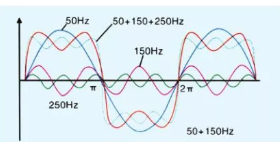
Representation diagram of various harmonic characteristics
IEC harmonic update limits the scope of exemption
• Updated the test-free range for stand-alone phase-controlled dimmers
• For incandescent lamps: the rated power does not exceed 1KW
• For lighting equipment other than incandescent lamps: trailing edge dimmer and default mode. The rated power of general-purpose phase-controlled dimmers for trailing edge dimming does not exceed 200W;
• For lighting equipment other than incandescent lamps: leading edge dimmers and universal phase-controlled dimmer with trailing edge dimming mode, rated power not exceeding 100W;
• For a stand-alone phase-controlled dimmer with rated power >100W or >200W (depending on the type of phase-controlled dimmer) and ≤1000W, which can be connected to incandescent or non-incandescent lighting loads, when the incandescent lamp is terminated, no harmonic current limit requirements. However, when connected to a non-incandescent lamp load, the dimmer must meet the requirements of the corresponding harmonic current limit.

Figure 1 Leading edge phase control

Figure 2 Trailing edge phase control
IEC harmonic main changes;
Includes the following: Lamps and Fixtures
One of the main functions is the lighting part of the multi-functional equipment for lighting;
Self-contained lighting controls, (self-contained ballasts for older discharge lamps and free-standing transformers for incandescent lamps) ultraviolet or infrared radiation devices;
Lighting of advertising signs;
Self-contained dimmers, non-phase air dimmers for lighting equipment, (older versions of dimmers for lamps other than incandescent lamps);
And the new DLT control device does not include the following:
Built-in lighting fixtures for equipment with other primary functions (such as copiers, projectors and slide projectors), or lighting fixtures for graduated or indicating purposes;
Phase Controlled Dimmer
Update in the new edition: Professional lighting for stage lighting and studio use, emergency lighting that only emits light in emergency mode, and some household appliances that include lighting fixtures.

Home lighting
IEC Harmonic Classification and Limits
• Rated power >25W
• Incandescent lighting fixtures with built-in phase-controlled dimmers
• other lighting equipment
• All lighting equipment products with 5W < rated power ≤ 25W (need to meet one of its three limit requirements)
• Rated power <5W: no limit requirement
• Control module with active power ≤ 2W: If the lighting equipment does not meet the limit requirements due to the control module and the supply current of the control module and the rest of the equipment can be measured separately, the contribution of the control module can be ignored, and only other components such as harmonic current value in the lighting equipment can be considered.
Limits for Class C lighting products (>25W)
• Lighting equipment products with rated power >25W shall not exceed the limits in Table 2
• Added test conditions
For lighting equipment with control methods such as dimming and color matching, the input current harmonics shall not exceed the limits in Table 2:
It is carried out with the following two test conditions and must meet the limit requirements.
• Adjust the control device to obtain the maximum power Pmax;
• Adjust control gear position at active power
(Pmin, Pmax) range, at the maximum THC.
If Pmax≤50w, Pmin=5w
If 50w<Pmax≤250w, Pmin=10%×Pmax
If Pmax>250w, Pmin=25w
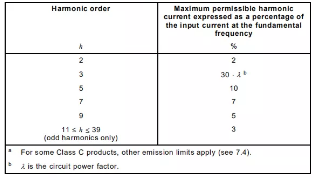
Table 2 Limits for Class C equipment
The new revisions are as follows:
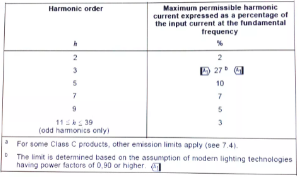
Table 2 Limits for Class C equipment(update)
For the lighting equipment with incandescent lamps and built-in phase control dimming with rated power > 25W, the harmonics of the input current shall not exceed the limits given in Table 1.
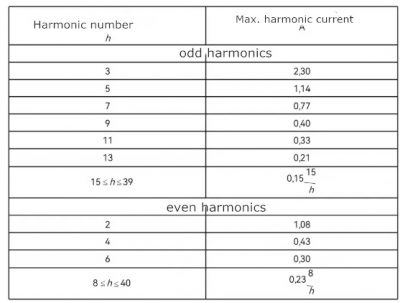
Table 1 – Limits for Class A Equipment
Limits for Class C lighting products (5w≥P≤25w)
(1) Lighting products with 5W≤rated power≤25W should meet one of the following three requirements;
• Requirement 1: Harmonic currents do not exceed the power-related limits in the second column of Table 3.
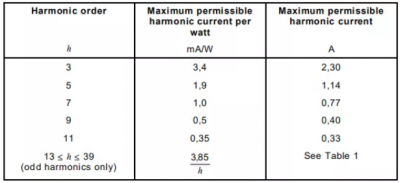
Limits for Class D equipment
(2) Expressed as a percentage of fundamental current, the third harmonic should not exceed 86%, and the fifth harmonic should not exceed 61%. In addition, the waveform of the input current should meet the following requirements: relative to the zero-crossing point of the fundamental supply voltage, it should reach a current threshold of 5 % at or before 60°, peak at or before 65°, and should not fall below 5% current threshold before 90°. The current threshold is equal to 5 % of the maximum absolute peak current that occurs in the measurement window, and the phase angle test is also measured during the period containing this absolute peak.
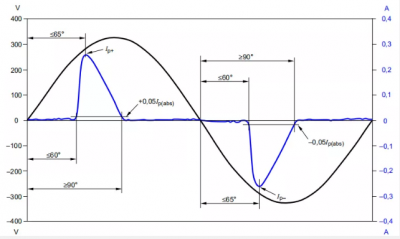
Fundamental current waveform
(3)THD should not exceed 70%. Expressed as a percentage of fundamental current, the 3rd harmonic current should not exceed 35%, the 5th harmonic current should not exceed 25%, the 7th harmonic current should not exceed 30%, the 9th and 11th harmonic currents should not exceed 20 % and the 2nd harmonic should not exceed 5 %.
Measuring Instrument Requirements:
1. Digital Power Meter (High Accuracy Model)
• The LS2050C and LS2050C-IEC are fully meet LM-79-19 requirements and the frequency Range: 0.5Hz-100kHz
• The software can measure U(AC&DC), I(AC&DC), P(AC&DC), Power Factor PF(AC), Displacement Factor DF(AC) and Total 0-50 Harmonic in IEC/CSA. Click here to see the LS2050B/LS2050C/LS2050C-IEC Test Report Sample
• The LS2050C-IEC hardware is the same as LS2050C, but with additional software to fully meet EN/IEC61000-3-2:2019, please click here to see the LS2050C-IEC additional Test Report Sample
2. LED Power Driver Tester
LS2090-IEC LED Power Driver Test Instrument is the comprehensive test instrument for LED driver power which is according to GB/T 24825-2009 and IEC 62384:2006. It can measure the following parameters: input (AC&DC), output (AC&DC), output start (DC) and harmonic.
The LS2090-IEC usually works with LISUN LSP-500VARC pure sine AC Power Source and LISUN M9822 DC Electronic Load. The LSP 500VARC provides constant adjustable voltage for the driver under test, and the M9822 is used to simulate the LED source. The software can run on Win7, Win8 and Win10, Win11.
Lisun Instruments Limited was found by LISUN GROUP in 2003. LISUN quality system has been strictly certified by ISO9001:2015. As a CIE Membership, LISUN products are designed based on CIE, IEC and other international or national standards. All products passed CE certificate and authenticated by the third party lab.
Our main products are Goniophotometer, Integrating Sphere, Spectroradiometer, Surge Generator, ESD Simulator, EMI Receiver, EMC Test Equipment, Electrical Safety Tester, Environmental Chamber, Temperature Chamber, Climate Chamber, Thermal Chamber, Salt Spray Test, Dust Test Chamber, Waterproof Test, RoHS Test (EDXRF), Glow Wire Test and Needle Flame Test.
Please feel free to contact us if you need any support.
Tech Dep: Service@Lisungroup.com, Cell/WhatsApp:+8615317907381
Sales Dep: Sales@Lisungroup.com, Cell/WhatsApp:+8618917996096
Your email address will not be published. Required fields are marked *